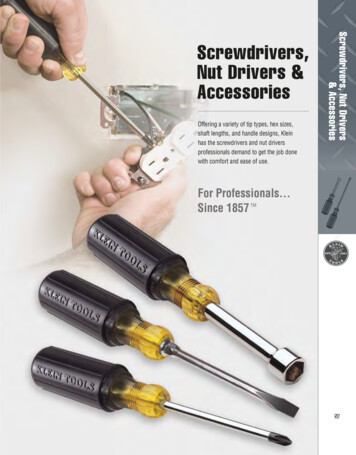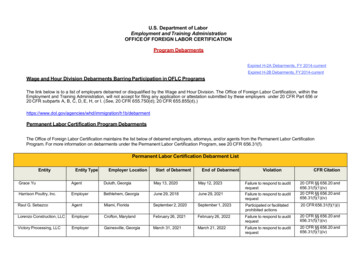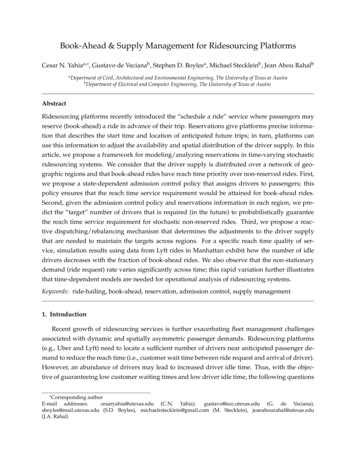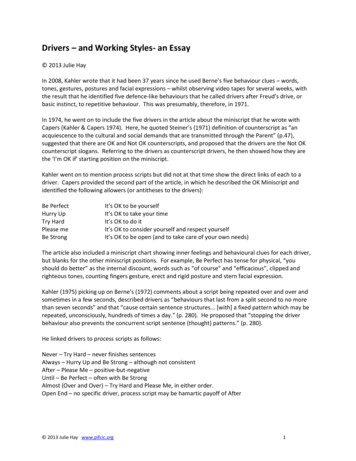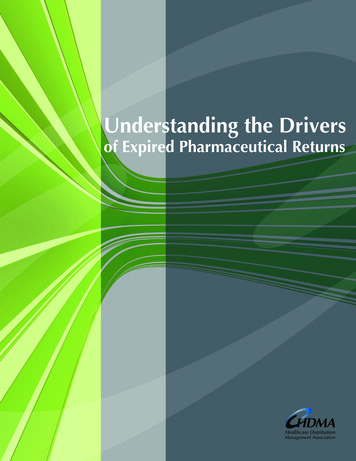
Transcription
1Understanding the Drivers of Expired Pharmaceutical Returns
Understanding the Drivers of Expired Pharmaceutical Returns2The Healthcare Distribution Management Association (HDMA) is the national associationrepresenting primary, full-service healthcare distributors. Each business day, the membercompanies of HDMA are responsible for ensuring that more than eight million prescriptionmedicines and healthcare products are safely delivered to 145,000 pharmacies, hospitals,nursing homes, physician offices, clinics, government and other providers in all 50 states.This essential public health function is provided with tremendous efficiency, saving thenation’s healthcare system nearly 32 billion each year. HDMA and its members arethe vital link in the healthcare system, working daily to provide value, remove costs anddevelop innovative solutions to deliver care safely and effectively.Recommendations in this report, Understanding the Drivers of Expired PharmaceuticalReturns, are intended to help distributors, manufacturers, healthcare providers andservice providers identify opportunities to improve inventory management andultimately reduce the volume of expired returns in the reverse supply chain. Allstakeholders involved in the project have a shared vision to reduce total supply chaincosts associated with unsaleable returned goods while preserving or improving thesafety and security of the healthcare supply chain.This report identifies several product-related and demand-related drivers of expiredpharmaceutical returns. This report also contains examples of process improvementsthat may help companies address and reduce the quantity of expired productsreturned, as well as track their progress in making these improvements. Movingforward, the adoption of track-and-trace technologies may enable companies tohave more control in managing inventory and ultimately limit the volume of expiredpharmaceutical returns. A company may wish to consider using the information inthis report in its own, individual business practices or in conjunction with its tradingpartners in order to reduce the quantity of returns.This report and its associated project are key components of HDMA’s vision andongoing efforts to promote enhanced data sharing within the healthcare supply chain.These efforts are part of an overall strategy to advance best business practices andimprove supply chain security and patient safety.
Understanding the Drivers of Expired Pharmaceutical ReturnsUnderstanding the Drivers3of Expired Pharmaceutical ReturnsReducing the Quantity of Expired Pharmaceuticalsin the Healthcare Supply ChainDeveloped for theReturns Task ForcePrepared byMay 2009Project SupportersHDMA would like to extend our appreciation to the supporters of this project:R
4Understanding the Drivers of Expired Pharmaceutical Returns
Understanding the DriversUnderstanding the Drivers of Expired Pharmaceutical Returnsof Expired Pharmaceutical Returns OVERVIEW6 HDMA RETURNS TASK FORCE6 PROJECT TEAM7 INTRODUCTION8 THE OPPORTUNITY8 INVENTORY VISIBILITY9 RETURNS DRIVERS: SUMMARY10 RETURNS DRIVERS: DETAILS12 APPENDIX A: LEADERS IN RETURNED GOODS MANAGEMENT23 APPENDIX B: IMPACT AND DIFFICULTY OF RETURNS DRIVERS25 APPENDIX C: INDUSTRY PROJECTION FOR VALUE OF EXPIRED Rx RETURNS265Copyright 2009 by Healthcare Distribution Management Association, United States. All rights reserved.This publication may not be reproduced, stored in any informational retrieval system or transmitted inwhole or in part by any means – electronic, mechanical, photocopying, recording or otherwise – withoutthe express written permission of the Healthcare Distribution Management Association (HDMA).ISBN: 978-0-9802095-9-4
OVERVIEWUnderstanding the Drivers of Expired Pharmaceutical ReturnsThis report describes the major causes that contribute to unsaleable pharmaceuticalreturns, actions an individual company may take to decrease its unsaleable returns andways to evaluate progress in decreasing unsaleable returns. The report covers unsaleablepharmaceutical returns which are expired, about to expire or will eventually expire beforethey can be sold. The report explores two points in the supply chain – the pharmacy and thewarehouse – to determine where and why pharmaceutical returns typically occur.6Understanding the Drivers of Expired Pharmaceuticals Returns includes: Recommendations that may help a company address the causes of and reduce expiredpharmaceutical returns. An evaluation tool that a distributor or manufacturer could use to determine whatopportunities a company has to improve and to measure the progress it has made.Relevant information from previous HDMA publications is included in this report, as well.This report describes factors and practices within the healthcare supply chain that mayincrease the amount of unsaleable pharmaceuticals, i.e., the drivers of expired pharmaceuticalreturns. It also contains information about what an individual company, or a company inconjunction with its trading partner, might wish to do in order to reduce expired returns. Inthis report, the term “distributor” refers to wholesalers, but may also include self-distributingretailers and any other company that processes and/or stores pharmaceutical products, such asmail order fulfillment centers.Each company must develop its own, individual returns management practices, and mustindividually choose how to deal and contract with its industry partners, suppliers and customers.HDMA RETURNS TASK FORCEThis report was developed by the HDMA Returns Task Force (RTF), whose mission is toidentify best practices and develop recommendations that address key issues and improveprocesses and technology efficiencies for returned and/or unsaleable healthcare products.Raftery Resource Network, Inc. (R2N), an independent consulting firm with subject matterexpertise, facilitated the report.The RTF is comprised of representatives from major segments of the healthcare industry,including manufacturers and distributors of healthcare products and service providers to thehealthcare supply chain. For this report, the RTF has expanded the scope of its work effort toinclude healthcare providers, as well. Many members of the RTF, along with representatives ofretail and institutional pharmacies, provided subject matter expertise for this report.
PROJECT TEAMHDMA recognizes the following individuals and companies who invested their time andexpertise as project team members to assist in developing this report through participation infacilitated focus group discussions, qualitative interviews and collective review.Ms. Joanne Cooper, Manager, Corporate Relations, AmeriCaresMr. Michael Kody, Vice President, Supply Chain Strategy, AmerisourceBergen Drug CompanyUnderstanding the Drivers of Expired Pharmaceutical ReturnsMs. Margaret Kinder, Senior Returns Analyst, Baxter HealthcareMr. Frank Harkins, Associate Director, Credit & Collections, Boehringer Ingelheim Pharmaceuticals, Inc.Mr. Neil Warren, Vice President, Industry & Supplier Relations, Cardinal Health, Inc.Ms. Samantha Trudeau, Logistics Analyst, Cephalon Inc.Ms. Tiffany Rowley, Trade Relations Manager, Covidien - MallinckrodtMs. Lisa Fowler, Pharm. D., Director Management and Professional Affairs,National Community Pharmacists AssociationMs. Martha Greene, Senior Operations Manager, Genentech USA*Mr. Thomas Bloemeke, Manager, Returns and Recalls, GlaxoSmithKlineMr. Robert J. Schaltenbrand, Director, Strategic Development, Guaranteed ReturnsMr. Thomas J. Twitty, Vice President, Operations, H. D. SmithMr. Steven Marcus, R.Ph., MBA, Executive Vice President, Health One Management CompanyMr. Cray Lester, Pharmacy Supply Chain, HEBMs. Jennifer Mauldin, Executive Vice President, Inmar, Inc.*Mr. Scott Bradford, Vice President, Reverse Logistics, McKesson CorporationMs. Diane Staub, Director of Sales, Support, and Operations, Novartis Pharmaceuticals CorporationMr. Robert Weston, Customer Service/Logistics Manager, Procter & Gamble PharmaceuticalsMr. Ed Crimmins, Senior Director, Pharmacy Returns, Rite Aid CorporationMr. Frank Lee, Director, Performance Development, Smith Drug CompanyMr. Bob Breetz, The Kroger CompanyMr. Tim Harris, Senior Director, Pharmacy Logistics, Wal-Mart Stores, Inc.Mr. Thomas Hervey, Logistics Operations Coordinator–Pharmacy, Wal-Mart Stores, Inc.*Project Team Leads7Advisor to the Returns Task Force:Mr. Daniel J. Raftery, President, Raftery Resource Network, Inc.
INTRODUCTIONUnderstanding the Drivers of Expired Pharmaceutical ReturnsLike many other industries, manufacturers of pharmaceutical products have historically createdreturned goods policies that offer credit for unsold products that meet specific criteria. Thesepolicies assist in sales efforts to distributors and retailers, particularly during the launch of newproducts.8Addressing returned goods in the healthcare supply chain offers an opportunity for total systemcost reductions. In the past, for instance, the industry has developed and improved methods forremoving expired products from pharmacies and other dispensers. However, this also has ledsome to rely on the returns process rather than on more proactive inventory management efforts.Several unavoidable circumstances influence demand for pharmaceuticals, which cansubsequently result in pharmaceuticals expiring, or nearing expiration, while still within thesupply chain. Examples include: Patients decide to obtain drug therapy elsewhere (from a different pharmacy, clinic or mailorder) or otherwise move on. Patients shorten or end their prescribed regimen (“patient non-compliance”). Patients are moved to a generic equivalent or a different course of treatment. Retailers compete aggressively for patients’ business. Negative information about a drug product arises (e.g., adverse events, manufacturingproblems).Returns systems serve several useful purposes; the most important is to guard patient safetythrough a controlled reverse logistics process. Trading partners have many opportunities toimprove inventory management processes and the timing of events and communications.The combined efforts of manufacturers, distributors, retailers and dispensers can contribute toreducing the overall quantity of expired pharmaceutical products.THE OPPORTUNITYDistributors, manufacturers and pharmacies have a significant opportunity to individuallyreduce costs by lowering the number of selling units that become expired.The projected value of all Rx products returned in the U.S. for which manufacturer creditis requested is estimated to be 2.6 - 4.2 billion1. Excluding recalls and overstock returns,the value of pharmaceutical products returned to distributors by their retail and institutionalcustomers averaged 15,918,825 per distribution center in 20072. In addition, handling,transportation and storage costs are associated with these returned goods.2008-2009 HDMA Factbook Data2006 2007Percent of all Rx selling units returned to distributor (median)1%1%Percent of all Rx selling units returned to manufacturer (median)2%2%1See Appendix C.2See the 2008-2009 HDMA Factbook.
Data from the annual 2008-2009 HDMA Factbook survey show relatively consistentpercentages of pharmaceutical returns for distributors and manufacturers over the mostrecent two consecutive years.Understanding the Drivers of Expired Pharmaceutical ReturnsAlthough these data reflect multiple causes for returns, among those on the RTF who processpharmaceutical returned goods, product expiration is generally considered to be the maincause. According to 26 manufacturers participating in the 2008-2009 HDMA Factbook survey,72 percent of all returns are either “out dated or short dated.”9INVENTORY VISIBILITYThe focus of this report is to understand what causes pharmaceuticals to remain unsold beforetheir expiration dates – identifying the “drivers” of returns. A critical first step for a companythat wants to reduce the quantity of expired products under its control is to be able to identifyhow much inventory exists at various points in its supply chain and how much is dispensed.Distributors function as the focal point or consolidator for both forward and reverse distributionof healthcare products sold from their own inventory. However, after products leave thedistribution warehouse, the distributor’s awareness of the inventory currently in the distributionpipeline is limited. This lack of total supply chain visibility inventory limits problem-solving andforecasting efforts by manufacturers and distributors.Typically, a manufacturer becomes aware of the existence of expired products when the productsbegin the journey back to the manufacturer through the reverse distribution pipeline. The followingsteps may help individual supply chain participants address the volume of returned goods: Analyzing “morgue” inventory in pharmacies, institutions and warehouses (i.e., productswith inadequate shelf-life according to the owner’s standards for distribution and which donot qualify for manufacturer credit until a later date). Collecting “reason code” data (i.e., details about the condition of the product or the reasonit is being returned) and lot number and expiration date. Communicating these data with appropriate supply chain partners, using advancedElectronic Data Interchange (EDI) technologies where possible (e.g., in addition to manyother applications, the 852 EDI transaction set can be used for unsaleable returns inventory;the 867 EDI transaction set can be used to see retail sales and returns; the 180 EDItransaction set can be used for a return authorization request or notification; and the 812EDI transaction set can be used for credit/debit adjustments).Although the basic collection of these data will not by itself reduce the quantity of expiredproducts and could require capital investments, a company with this information can supportprocedural improvements by identifying where and why expiration occurs in the supply chainand evaluating its efforts to reduce the occurrence of product expiration. Morgue inventorylevels and reason codes are currently being used by several companies to track andcommunicate improvement opportunities. As more companies compile, analyze and applythese data, the entire supply chain will benefit.
RETURNS DRIVERS: SUMMARYThese eleven drivers of expired pharmaceutical returns are listed in a sequence developed bythe HDMA Project Team that represents the most significant and feasible for a company toaddress3. These drivers are discussed in more detail in the following section.DriverDescriptionPossible Actions for a Company1. Pharmacy stock rotationPharmacies generally stock 3,500-4,000SKUs. Most pharmacy inventory isorganized alphabetically. Highly manualprocess to collect expiration information.Many SKUs are very slow movers andare stocked with fast movers.Conduct periodic checks on dating androtate inventory. Cycle through entireinventory over defined period.Transfer excess inventory to activelydispensing stores. Exception: certain acutemedications.Some retail systems show all inventory in adistrict. Pharmacist can direct patient to storetoday or arrange for a transfer tomorrow.Demand- and Inventory-Related DriversUnderstanding the Drivers of Expired Pharmaceutical ReturnsPrimary Drivers of Expired Pharmaceutical Returns2. Alignment ofmanufacturer anddistributor ship lifepolicies with manufacturerproduction and inventorypracticesIn general, retailers and distributors wantRx product with 1 year or more shelf lifeand do not ship to stores with less than 6months. Biotech (with 3 month efficacy)is an exception. As a result of FDAactions, a new batch could have longerdating than prior batch.3. Retail pharmacy practicesfor short-dated productsRetailers often pull products off the shelf90 days prior to expiration. Distributorsusually ship with at least 6-7 monthsshelf life remaining. Short shelf lifesituation with biotech or specialtyproducts, e.g., 3 months.Monthly inventory inspections for expirationdate can find items in stores with less than 90days shelf life.Products need to be in store when patientsarrive. Inventory build-up may occur.If season is soft, return rates are higher.Fall-off rate can be very steep; high salesvolume exists until the end of season.Hold inventory in distribution center (DC)vs. store for quick response to increaseddispensing needs.4. Drop in demand forseasonal Rx productsManufacturers should consider 12 monthsminimum ship life.Alert distributor and retailer to shorter life.Might include written approval to ship.Develop special communications for slowmovers to alert pharmacies.Special order specialty products with shortshelf life as needed.Educate patients about expiration date andefficacy.Intra-company transfers move product from“cold” to “hot” dispensing locations.DC to DC transfers accommodate regionaldemand variations.5. Warehouse stock rotation106. Investment buying/forward buying at retail andby institutions3Larger distributors generally carry36,000-40,000 total SKUs. ServiceLevel Commitments cover any patientrequest at pharmacy level. Broadvariety of products: brand/generic; slowmovers/fast movers; maintenance/acute.Rationalize SKUs based on demand.Service levels may decline as trade-off.Distributor service agreementsbetween individual trading partnershave generally curtailed this activity.Exception: seasonal items requireforward buying. Tiered contracts atinstitutions may cause some forwardbuying to get rebate at end of quarter.Additional actions might be identifiedthrough discussions with trading partnersand legal counsel.See Appendix B for more information.Slow movers, such as maintenance drugs,could be sourced via wholesaler ordispensed via mail order.Use expiration date data in warehousemanagement systems.
11Product-Related DriversUnderstanding the Drivers of Expired Pharmaceutical ReturnsPrimary Drivers of Expired Pharmaceutical Returns (cont.)DriverDescriptionPossible Actions for a Company7. New product failuresMarket share forecasts drive productionand distribution. Communications toprescribers may lag behind distribution.Actual demand may be lower than prelaunch forecasts.Manufacturer should consider coordinatingproduct delivery with communications toprescribers. Instructions from manufacturerto distributor should cover the completeproduct lifecycle. Retailers and distributorscould evaluate new item performance andrebalance inventory.8. Unit of dispensing is notstandardized.Prescribing practices often differ fromhow product is packaged. Most scripts arewritten in multiples of 30. Many are for28. Multiple ways to order (e.g., 30, 100or 1,000). No standard practice for mixinglots. Dispensing practices vary by channel.Some chains like unit-of-use packaging,e.g., 30 or 28.Generic launches cause increasedreturns of branded products. If supplychain partners do not properlyanticipate the launch, returns can besubstantial. A single generic item canbe supplied by multiple vendors.Manufacturers should forecast for brandedreturns after patent expiration.Product acquisitions and divestituresamong manufacturers result in NDCconversions of the product. Sales ofold NDC may stop before inventory isdepleted.Old and new NDCs for identical productscan be linked in inventory managementsystems so that new inventory is not solduntil old inventory is depleted.For drugs marketed without FDAapproval, FDA might issue a “do notsell past X date” rule. Inventory canremain in the supply chain. Stateregulations about redistribution vary.Some manufacturers work with FDA toobtain approvals or extend transition period.9. Generic productintroductions10. National Drug Codeconversions11. Government actions,such as FDA enforcementactionsSome manufacturers have developed newproducts in multiples of 30 counts (e.g., 180).Consider seeking FDA approval forunit-of-use packaging when it makes sense.The pharmacy, distributor and manufacturershould increase communications prior
Mr. Tim Harris, Senior Director, Pharmacy Logistics, Wal-Mart Stores, Inc. . Wal-Mart Stores, Inc. *Project Team Leads Advisor to the Returns Task Force: Mr. Daniel J. Raftery, President, Raftery Resource Network, Inc. Understanding the Drivers of Expired Pharmaceutical Returns . the 867 EDI transaction



